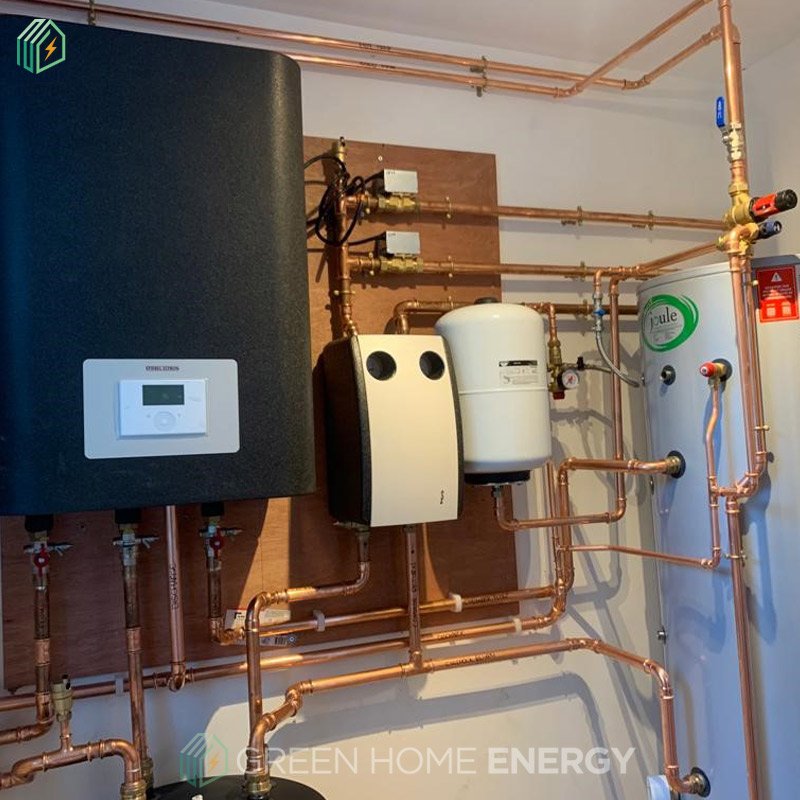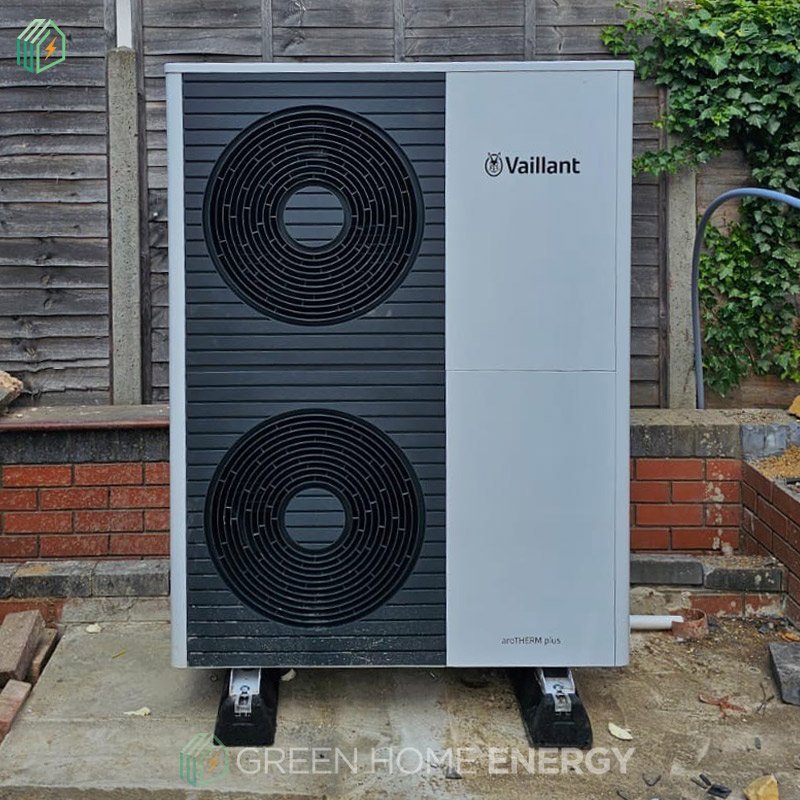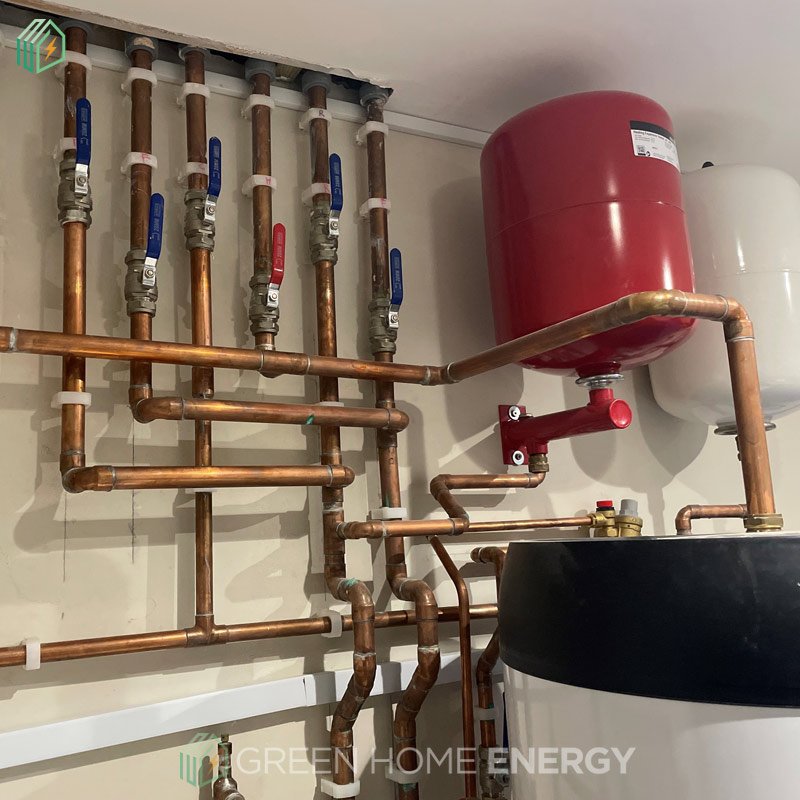Air Source Heat Pump (ASHP)



A local solution for global problems
Heat Pumps are becoming more common in the UK as fossil fuel boilers are slowly being phased out. For most properties, this is the easiest option for replacing a boiler with a renewable heating system.
In order to reach the UK’s Net Zero 2050 target, we need to reduce heating emissions by 95%. In all the scenarios and predictive models, heat pumps have a major role to play as they are the most scalable solution that is available right now. Heat pumps offer flexibility on input fuel prices, no on-site emissions or air pollution, minimal infrastructure upgrade and highly integratable with other technologies. Switching to a low-carbon heat pump is a bit more complex than just upgrading your old boiler with a newer one.
Currently, there are financial incentives for people who adopt this technology early. As energy costs rise and environmental concerns grow, heat pumps are revolutionising home heating systems across the UK. These sustainable alternatives to traditional wood, gas and oil systems offer remarkable efficiency without combustion. Heat pumps do not need to combust anything as they are not a source of energy in themselves e.g. wood and gas, but simply move energy from one place to another.
What is an Air Source Heat Pump?
A heat pump is a renewable energy system that transfers heat from an external source (ground, air or water) into the home. Heat pumps come in several forms, and each one works a little differently.
A heat pump system that takes heat from the outside air is an Air Source Heat Pump, sometimes called an air-to-water heat pump. Air Source Heat Pumps take heat from the air and transfer it to a fluid refrigerant, passes through a compressor, which raises the fluid’s temperature and transfers the heat to your central heating system and also provide hot water. Although the air is colder in winter months, there is still a lot of energy generated due to the amount of air that passes over the heat exchanger. An Air Source Heat Pump is similar to an air conditioning unit working in reverse.
Types of Air Source Heat Pumps
There are two main types: Monobloc and Split systems.
Monobloc system has all the components in a single outdoor unit. Pipes carry water to the central heating system and a hot water cylinder inside your home. This system tends to be more common because they are cheaper and quicker to install. They do not take up as much space inside your home.
Split system separates the heat pump into indoor and outdoor units. These systems can be more efficient because some of the heat transfer takes place inside the building where it is warmer, resulting in less heat being lost.



Typical cost of installing an Air Source Heat Pump
Every installation we do is bespoke and tailored to your home, making there is no one price for all. The cost of installation of an Air Source Heat Pump varies depending on:
- The size of your property
- Level of loft and wall insulation
- Whether it is a newbuild or an existing property
- Whether you need to upgrade your radiators
- The size of Air Source Heat Pump(s)
Advantages of an Air Source Heat Pump
- Suitability – ideal for either retrofit or new buildings.
- Future proof your property – Gas and oil boilers will gradually be phased out to meet the Government’s climate commitments so Air Source Heat Pump is a popular option. You future-proof your property and make it more attractive for future buyers.
- Efficiency – highly efficient and can generate between 2-4 times more renewable heat energy than the electrical energy they consume.
- Carbon Footprint – replacing a gas or oil boiler with a heat pump reduces CO2 emissions so environmentally friendly than traditional alternatives as they don’t burn any fossil fuels.
- Easy integration – minimal home modifications required with easy integration into the existing radiators and pipes.
- Heating & Hot Water – provides heating and hot water requirements.
- Advanced Temperature Controls – you can set your controls to match the level of heating and hot water you need and consistent temperature and comfort rather than cycling on and off, providing more comfortable heating while using less energy.
- Under Floor Heating – work well with underfloor heating because they are at their most efficient when producing low water temperatures.
- Safety – no need for an oil or LPG tank which can leak or ignite.
- Maintenance – minimal maintenance required
- Running costs – potential savings would depend upon several factors such as replaced fuel, especially if switching from a standard electric boiler, electric heaters or an oil or LPG system, age of the replaced boiler, type of heat pump and quality of the heating distribution system.
- Powered by Solar Panels – use solar panels to generate electricity that powers a heat pump, lowering your energy bills and carbon footprint even further. However, it is not the perfect integration because you generally need heating when the days are shorter and darker in winter when your solar panels are not generating as much.
- Grant – benefit from the Government’s Boiler Upgrade Scheme (BUS) grant. If you live in England and Wales, you can get £7,500 towards an air source heat pump with the Boiler Upgrade Scheme.
- Zero Percent VAT – Currently there is no VAT on installation of Air Source Heat Pump system
- Permitted Developments – Heat pump installations are considered ‘permitted developments’, meaning you may not need planning permission. However, there are exceptions, and it is best to check with your local planning department, especially important if you live in a listed building or conservation area as well as for a larger heat pump.
Disadvantages of an Air Source Heat Pump
- Upfront costs – although the Boiler Upgrade Scheme is offering £7,500 towards the cost of an Air Source Heat Pump, the system can still cost more than a new gas boiler.
- Noise – Air Source Heat Pumps can be noisier than other boilers. Make sure you check the decibel rating of the make and model being considered for your property.
- Space – Air Source Heat Pump require outdoor space and generally installed against an external wall but smaller units can be wall mounted.
- Temperature – As the outdoor temperature drops, the coefficient of an ASHP will drop. If it gets very cold outside and the heat pump has not been sized and installed correctly or if the house is not energy efficient, an Air Source Heat Pump could struggle to effectively heat a property.
- Maintenance – as with all boilers, Air Source Heat Pumps also require annual maintenance. Although it requires less maintenance, you will need a qualified heat pump engineer.
Frequently asked questions (FAQs)
An ASHP can be installed in a range of properties, whether small or large, newbuild or retrofit, rural or urban. It is right for you if you are looking for a low-carbon, eco-friendly and sustainable way to heat your home. The property must be well insulated for efficiency and keeping running costs low.
You will need circa 1.4. x 0.8m space to house the plant room equipment inside your home. The Air Source Heat Pump unit will be installed outside.
Air Source Heat Pumps work at lower temperatures than a traditional heating system like gas boiler and therefore insulation is key to getting the most out of the heat pump system. A poorly insulated home will not reap the benefits of a heat pump, so this should be addressed before installing one. If you can stop heat escaping from your home, a heat pump will be able to maintain a comfortable temperature all year round.
The best insulation for heat pumps is whatever is most effective at helping your home retain its heat. Here are some areas to consider for insulating your home.
Loft Insulation – this is perhaps the most effective method of home insulation. A house loses more heat from its roof than anywhere else, just as humans lose most of their heat through their head. Ideally, you should insulate your loft with at least 270mm, ideally 300mm of mineral wool insulation. The insulation can either be installed between the joists or in the rafters. Installing it between the joists will keep the living space below the loft warm, and the loft cool. Installing insulation on the rafters will keep the loft warm, and allow you to use it as a living space, not just for storage.
Wall Insulation – the cavity wall insulation is put into the cavity of the wall. If your property has solid walls, this means that insulating it will have to be done on the inside or the outside, which is slightly more costly than within the cavity. Most homes built since the 1990s will have adequate insulation within their walls. These homes will retain their heat better than older houses, and will reap the benefits of a heat pump more easily. Insulating your walls also means that while your property retains heat in the colder months, it will stay a little cooler in the summer.
Double Glazing – windows are a common escape method for heat. Ensuring your windows are at least double glazed is another great way of ensuring your home retains heat and you get the most out of a heat pump.
When it is 0⁰c or below outside, the air does have heat energy in it. 0⁰c is simply the freezing point of water. There is still plenty of heat in the air.
If you hear issues of people struggling to heat properties with heat pumps when it is cold, that is simply because the lower outside temperatures show up any design, installation and commissioning flaws.
Heat pumps provide steady quantities of heat between 35°c and 55°c, rather than the quick blasts of 70°c to 80°c heat supplied by gas boilers. This helps heat pumps make more energy efficient, but it also means that they work best with radiators with a larger surface area and with Under Floor Heating. The size of the radiator depends on the heat requirement for each room.
Heat pumps are powered by electricity, unlike the gas boilers. Heating your home with a heat pump will increase your “electrical load”, which is the amount of electricity that flows into your home. Your qualified electrician will be able to take care of working out the electrical load of your property.
It is possible to install heat pumps in flats, but it is more complex than installing in houses. There is an additional complication that the leaseholders need permission from the freeholder to place a heat pump outside, which can be difficult to get. Also, the heat pump needs to be situated far enough away from neighbours’ windows to stay within planning permission rules, which can also be quite tricky to manage.
Most people have their heat pump unit installed at the back or on the side of the home, generally on the ground with a concrete base or wall mounted.
Let’s connect today
Have a query or need expert guidance on renewable energy solutions? Our friendly team is here to help so contact us and let’s build a greener future together.
SEND US A MESSAGE
CONTACT INFORMATION
Do you have questions about our services & solutions? Send us an email and we’ll get in touch shortly.
Follow Us
Connect with us to discover the latest in green energy, expert tips and exclusive offers. It only takes a second to stay informed and power your home sustainably!








